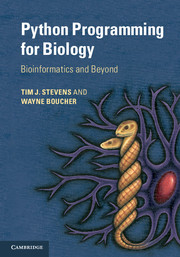Book contents
- Frontmatter
- Contents
- Preface
- Acknowledgements
- 1 Prologue
- 2 A beginners’ guide
- 3 Python basics
- 4 Program control and logic
- 5 Functions
- 6 Files
- 7 Object orientation
- 8 Object data modelling
- 9 Mathematics
- 10 Coding tips
- 11 Biological sequences
- 12 Pairwise sequence alignments
- 13 Multiple-sequence alignments
- 14 Sequence variation and evolution
- 15 Macromolecular structures
- 16 Array data
- 17 High-throughput sequence analyses
- 18 Images
- 19 Signal processing
- 20 Databases
- 21 Probability
- 22 Statistics
- 23 Clustering and discrimination
- 24 Machine learning
- 25 Hard problems
- 26 Graphical interfaces
- 27 Improving speed
- Appendices
- Glossary
- Index
- Plate section
2 - A beginners’ guide
Published online by Cambridge University Press: 05 February 2015
- Frontmatter
- Contents
- Preface
- Acknowledgements
- 1 Prologue
- 2 A beginners’ guide
- 3 Python basics
- 4 Program control and logic
- 5 Functions
- 6 Files
- 7 Object orientation
- 8 Object data modelling
- 9 Mathematics
- 10 Coding tips
- 11 Biological sequences
- 12 Pairwise sequence alignments
- 13 Multiple-sequence alignments
- 14 Sequence variation and evolution
- 15 Macromolecular structures
- 16 Array data
- 17 High-throughput sequence analyses
- 18 Images
- 19 Signal processing
- 20 Databases
- 21 Probability
- 22 Statistics
- 23 Clustering and discrimination
- 24 Machine learning
- 25 Hard problems
- 26 Graphical interfaces
- 27 Improving speed
- Appendices
- Glossary
- Index
- Plate section
Summary
Programming principles
The Python language can be viewed as a formalised system of understanding instructions (represented by letters, numbers and other funny characters) and acting upon those directions. Quite naturally, you have to put something in to get something out, and what you are going to be passing to Python is a series of commands. Python is itself a computer program, which is designed to interpret commands that are written in the Python language, and then act by executing what these instructions direct. A programmer will sometimes refer to such commands collectively as ‘code’.
Interpreting commands
So, to our first practical point; to get the Python interpreter to do something we will give it some commands in the form of a specially created piece of text. It is possible to give Python a series of commands one at a time, as we slowly type something into our computer. However, while giving Python instructions line by line is useful if you want to test out something small, like the examples in this chapter, for the most part this method of issuing commands is impractical. What we usually do instead is create all of the lines of text representing all the instructions, written as commands in the Python language, and store the whole lot in a file. We can then activate the Python interpreter program so that it reads all of the text from the file and acts on all of the commands issued within. A series of commands that we store together in such a way, and which do a specific job, can be considered as a computer program. If you would like to try any of the examples given in the book the next chapter will tell you how to actually get started. The initial intention, however, is mostly to give you a flavour of Python and introduce a few key principles.
- Type
- Chapter
- Information
- Python Programming for BiologyBioinformatics and Beyond, pp. 5 - 16Publisher: Cambridge University PressPrint publication year: 2015



